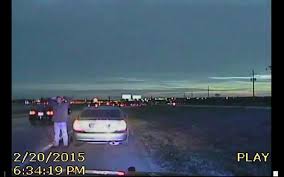 Police have been using dash cam videos for quite some time now. Police believe they are instrumental in demonstrating probable cause in a traffic stop as well as the ensuing encounter between the officer and those in the vehicle that’s been stopped.
Police have been using dash cam videos for quite some time now. Police believe they are instrumental in demonstrating probable cause in a traffic stop as well as the ensuing encounter between the officer and those in the vehicle that’s been stopped.
Yet, it’s not always that simple. A DUI stop in Clay County has resulted in the case being referred all the way to the state Supreme Court with the surprising result that the Supreme Court justices aren’t in agreement as to what the dash cam video revealed.
Joseph Wiggins was driving his pickup down a Clay County road in the early morning hours when he was stopped by a police officer on suspicion of drunk driving. During Wiggins’ court hearing the circuit judge reviewed the video and found that the video contradicted what was written in the police report. As a result, the circuit judge overturned the administrative hearing officer’s decision to suspend Wiggins’ license. The decision was appealed to the 1st Circuit and they ruled in favor of the officers. Wiggins appealed the decision to the state Supreme Court. In their decision, the state’s highest court backed the circuit judge’s decision to use the video evidence and pointed to the technological changes that have occurred in police work.
“We respect the authority and expertise of law enforcement officers, and thus rely on an officer’s memory when necessary,” said the majority opinion, written by Justice R. Fred Lewis and joined by Chief Justice Jorge Labarga, justices Barbara Pariente and Peggy Quince and Senior Justice James E.C. Perry. “But we would be remiss if we failed to acknowledge that at times, an officer’s human recollection and report may be contrary to that which actually happened as evinced in the real time video. This is the reality of human imperfection; we cannot expect officers to retain information as if he or she were a computer. Therefore, a judge who has the benefit of reviewing objective and neutral video evidence along with officer testimony cannot be expected to ignore that video evidence simply because it totally contradicts the officer’s recollection. Such a standard would produce an absurd result.”
But Justice Charles Canady, in a dissent joined by Justice Ricky Polston, disputed the majority’s interpretation of what was shown on the video and said the deputy’s “testimony and the video are competent, substantial evidence that support the hearing officer’s findings.”
The minority opinion argued that the circuit judge did not have the authority to re-weigh evidence and his decision was flawed.
That’s not the end of it. In reviewing the videotape, the justices had very different interpretations of what the video actually showed.
“The dashboard camera on Saunders’ vehicle recorded Wiggins’ driving pattern from the time Saunders first saw the vehicle to the time Wiggins was stopped,” Lewis wrote in the majority opinion. “As Saunders trailed Wiggins’ vehicle that night, the video showed Wiggins driving totally within the proper lines. Wiggins did not cross any lines, nor did he nearly hit the curb. Wiggins did change lanes only once in an apparent attempt to clear the lane for Saunders, but he utilized his turn signal before doing so. Wiggins then activated his turn signal to move into a left turn lane, braked in preparation to turn at a traffic light, and made a normal left turn once the traffic light turned green. As Wiggins turned left, Saunders activated his emergency lights.”
But that isn’t what Canady saw.
“What Deputy Saunders described in his narration can be seen on the video,” Canady’s dissent said. “Wiggins was not driving within the proper lines but was repeatedly driving on or over the fog line, nearly hit the curb on multiple occasions, and was drifting within his lane. The video shows that Deputy Saunders observed this driving pattern for several minutes before initiating a traffic stop. The video also clearly shows that just prior to the initiation of the traffic stop, Wiggins passed an opening for a left-turn lane and then slowly drifted over a solid white line into the turn lane before turning left. Additionally, Deputy Saunders testified and wrote in his report that Wiggins was driving 30 mph in a 45-mph zone and that these observations occurred at approximately 2:10 a.m.”
As you can see from this case, there is no such thing as a open and shut DUI case. Evidence can be determined to be illegal or legal, justices may have differing interpretations of video evidence, and they can have different views concerning judicial authority. There is no such thing as a clear cut DUI case. That’s why you need an experienced DUI lawyer if you’re stopped and arrested for driving under the influence.
